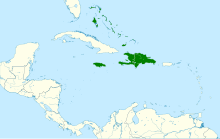| Greater Antillean bullfinch | |
|---|---|

| |
| M. v. affinis, Dominican Republic | |

| |
| M. v. ruficollis, Jamaica | |
| Conservation status | |
 Least Concern (IUCN 3.1) | |
| Scientific classification | |
| Domain: | Eukaryota |
| Kingdom: | Animalia |
| Phylum: | Chordata |
| Class: | Aves |
| Order: | Passeriformes |
| Family: | Thraupidae |
| Genus: | Melopyrrha |
| Species: | M. violacea |
| Binomial name | |
| Melopyrrha violacea (Linnaeus, 1758) | |

| |
| Synonyms | |
| |
The Greater Antillean bullfinch (Melopyrrha violacea) is a species of bird in the family Thraupidae.
Distribution and habitat
It is found in the Bahamas, Hispaniola (the Dominican Republic and Haiti, as well as surrounding islands), Jamaica, and the Turks and Caicos Islands. Its natural habitats are subtropical or tropical dry forest, subtropical or tropical moist lowland forest, subtropical or tropical moist montane forest, subtropical or tropical dry shrubland, and heavily degraded former forest.
Taxonomy
The Greater Antillean bullfinch was formally described by the Swedish naturalist Carl Linnaeus in 1758 in the tenth edition of his Systema Naturae under the binomial name Loxia violacea. The specific epithet violacea is from Latin violaceus meaning "violet-coloured". Linnaeus based his description on "The Purple Gross-beak" that had been described and illustrated by Mark Catesby in 1731. The type locality is the Bahamas.
This species was formerly placed in the genus Loxigilla. A molecular phylogenetic study published in 2014 found that Loxigilla was polyphyletic and in the subsequent rearrangement the Greater Antillean bullfinch and the Puerto Rican bullfinch were moved to Melopyrrha.
Subspecies
Five subspecies are recognised:
- M. v. violacea (Linnaeus, 1758) – north, central Bahamas
- M. v. ofella (Buden, 1986) – central, east Turks and Caicos Islands, south Bahamas
- M. v. maurella (Wetmore, 1929) – Tortue Island (off northwest Hispaniola)
- M. v. affinis (Ridgway, 1898) – Hispaniola and surrounding islands
- M. v. ruficollis (Gmelin, JF, 1789) – Jamaica
References
- BirdLife International (2022). "Pyrrhulagra violacea". IUCN Red List of Threatened Species. 2022: e.T22723628A219198969. Retrieved 14 December 2022.
- Linnaeus, Carl (1758). Systema Naturae per regna tria naturae, secundum classes, ordines, genera, species, cum characteribus, differentiis, synonymis, locis (in Latin). Vol. 1 (10th ed.). Holmiae (Stockholm): Laurentii Salvii. p. 176.
- Jobling, James A. (2010). The Helm Dictionary of Scientific Bird Names. London: Christopher Helm. p. 402. ISBN 978-1-4081-2501-4.
- Catesby, Mark (1729–1732). The Natural History of Carolina, Florida and the Bahama Islands (in English and French). Vol. 1. London: W. Innys and R. Manby. p. 40, Plate 40.
- ^ Paynter, Raymond A. Jr, ed. (1970). Check-List of Birds of the World. Vol. 13. Cambridge, Massachusetts: Museum of Comparative Zoology. p. 188.
- Burns, K.J.; Shultz, A.J.; Title, P.O.; Mason, N.A.; Barker, F.K.; Klicka, J.; Lanyon, S.M.; Lovette, I.J. (2014). "Phylogenetics and diversification of tanagers (Passeriformes: Thraupidae), the largest radiation of Neotropical songbirds". Molecular Phylogenetics and Evolution. 75: 41–77. doi:10.1016/j.ympev.2014.02.006. PMID 24583021.
- ^ Gill, Frank; Donsker, David; Rasmussen, Pamela, eds. (July 2020). "Tanagers and allies". IOC World Bird List Version 10.2. International Ornithologists' Union. Retrieved 28 November 2020.
Further reading
- Raffaele, Herbert; James Wiley, Orlando Garrido, Allan Keith & Janis Raffaele (2003) Birds of the West Indies, Christopher Helm, London.
| Taxon identifiers | |
|---|---|
| Loxigilla violacea | |
| Loxia violacea | |
This article about a tanager is a stub. You can help Misplaced Pages by expanding it. |